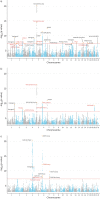A large-scale genome-wide association analysis of lung function in the Chinese population identifies novel loci and highlights shared genetic aetiology with obesity
- PMID: 33766948
- PMCID: PMC8513692
- DOI: 10.1183/13993003.00199-2021
A large-scale genome-wide association analysis of lung function in the Chinese population identifies novel loci and highlights shared genetic aetiology with obesity
Abstract
Background: Lung function is a heritable complex phenotype with obesity being one of its important risk factors. However, knowledge of their shared genetic basis is limited. Most genome-wide association studies (GWASs) for lung function have been based on European populations, limiting the generalisability across populations. Large-scale lung function GWASs in other populations are lacking.
Methods: We included 100 285 subjects from the China Kadoorie Biobank (CKB). To identify novel loci for lung function, single-trait GWAS analyses were performed on forced expiratory volume in 1 s (FEV1), forced vital capacity (FVC) and FEV1/FVC in the CKB. We then performed genome-wide cross-trait analysis between lung function and obesity traits (body mass index (BMI), BMI-adjusted waist-to-hip ratio and BMI-adjusted waist circumference) to investigate the shared genetic effects in the CKB. Finally, polygenic risk scores (PRSs) of lung function were developed in the CKB and their interaction with BMI's association on lung function were examined. We also conducted cross-trait analysis in parallel with the CKB using up to 457 756 subjects from the UK Biobank (UKB) for replication and investigation of ancestry-specific effects.
Results: We identified nine genome-wide significant novel loci for FEV1, six for FVC and three for FEV1/FVC in the CKB. FEV1 and FVC showed significant negative genetic correlation with obesity traits in both the CKB and UKB. Genetic loci shared between lung function and obesity traits highlighted important biological pathways, including cell proliferation, embryo, skeletal and tissue development, and regulation of gene expression. Mendelian randomisation analysis suggested significant negative causal effects of BMI on FEV1 and on FVC in both the CKB and UKB. Lung function PRSs significantly modified the effect of change in BMI on change in lung function during an average follow-up of 8 years.
Conclusion: This large-scale GWAS of lung function identified novel loci and shared genetic aetiology between lung function and obesity. Change in BMI might affect change in lung function differently according to a subject's polygenic background. These findings may open new avenues for the development of molecular-targeted therapies for obesity and lung function improvement.
Copyright ©The authors 2021.
Conflict of interest statement
Conflict of interest: Z. Zhu has nothing to disclose. Conflict of interest: J. Li has nothing to disclose. Conflict of interest: J. Si has nothing to disclose. Conflict of interest: B. Ma has nothing to disclose. Conflict of interest: H. Shi has nothing to disclose. Conflict of interest: J. Lv has nothing to disclose. Conflict of interest: W. Cao has nothing to disclose. Conflict of interest: Y. Guo has nothing to disclose. Conflict of interest: I.Y. Millwood has nothing to disclose. Conflict of interest: R.G. Walters has nothing to disclose. Conflict of interest: K. Lin has nothing to disclose. Conflict of interest: L. Yang has nothing to disclose. Conflict of interest: Y. Chen has nothing to disclose. Conflict of interest: H. Du has nothing to disclose. Conflict of interest: B. Yu has nothing to disclose. Conflict of interest: K. Hasegawa reports grants from the NIH and Novartis, outside the submitted work. Conflict of interest: C.A. Camargo Jr has nothing to disclose. Conflict of interest: M.F. Moffatt has nothing to disclose. Conflict of interest: W.O.C. Cookson has nothing to disclose. Conflict of interest: J. Chen has nothing to disclose. Conflict of interest: Z. Chen has nothing to disclose. Conflict of interest: L. Li has nothing to disclose. Conflict of interest: C. Yu has nothing to disclose. Conflict of interest: L. Liang has nothing to disclose.
Figures




Comment in
-
Improving ethnic diversity in respiratory genomics research.Eur Respir J. 2021 Oct 14;58(4):2101615. doi: 10.1183/13993003.01615-2021. Print 2021 Oct. Eur Respir J. 2021. PMID: 34649971 No abstract available.
References
-
- Ostrowski S, Barud W. Factors influencing lung function: are the predicted values for spirometry reliable enough? J Physiol Pharmacol 2006; 57: Suppl. 4, 263–271. - PubMed
-
- World Health Organization . Obesity and overweight. 2020. www.who.int/news-room/fact-sheets/detail/obesity-and-overweight Date last accessed: 1 July 2020.
Publication types
MeSH terms
Grants and funding
- MC_U137686851/MRC_/Medical Research Council/United Kingdom
- 16896/CRUK_/Cancer Research UK/United Kingdom
- 212946/WT_/Wellcome Trust/United Kingdom
- MC_PC_14135/MRC_/Medical Research Council/United Kingdom
- MC_UU_00017/1/MRC_/Medical Research Council/United Kingdom
- K01 AI153558/AI/NIAID NIH HHS/United States
- MC_PC_17228/MRC_/Medical Research Council/United Kingdom
- MC_QA137853/MRC_/Medical Research Council/United Kingdom
- 29186/CRUK_/Cancer Research UK/United Kingdom
- MC_UU_12026/2/MRC_/Medical Research Council/United Kingdom
- 202922/WT_/Wellcome Trust/United Kingdom
- MC_PC_13049/MRC_/Medical Research Council/United Kingdom
- 088158/WT_/Wellcome Trust/United Kingdom
- MR/P025080/1/MRC_/Medical Research Council/United Kingdom
- 104085/WT_/Wellcome Trust/United Kingdom
LinkOut - more resources
Full Text Sources
Other Literature Sources
Research Materials
Miscellaneous
